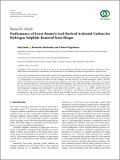| dc.description.abstract | In this study, sweet potato leaf activated carbon (SpLAC) was prepared by the chemical activation method using KOH and applied as an adsorbent for H2S removal from biogas. The study focused on the understanding of the effect of carbonization temperature (), varying KOH : C activation ratio, flow rate (FR) of biogas, and mass of SpLAC on sample adsorption capacity. The BET analysis was performed for both fresh and spent activated carbons as well as for carbonized samples, which were not activated; also, the activated carbon was characterized by XRF and CHNS techniques. The results showed that removal efficiency (RE) of the SpLAC increased with increase carbonization temperature from 600 to 800°C and the mass of sorbent from 0.4 g to 1.0 g. The optimal test conditions were determined: 1.0 g of sorbent with a KOH : C ratio of 1 : 1, °C, and m3/h which resulted in a sorption capacity of about 3.7 g S/100 g of the SpLAC. Our findings corroborated that H2S removal was contributed not only by the adsorption process with the pore available but also by the presence of iron in the sample that reacted with H2S. Therefore, upon successful H2S sorption, SpLAC is suggested as a viable adsorbent for H2S removal from biogas. | en_US |

